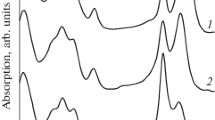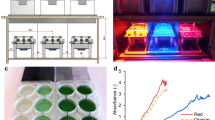Abstract
Rhodopseudomonas sphaeroides mutant H5 lacking 5-aminolevulinic acid synthase was employed to study the control of the formation of total bacteriochlorophyll as well as of the B875- and B850-bacteriochlorophyll protein complexes. The organisms were grown phototrophically in a chemostat where cell protein formation was limited by iron ions and bacteriochlorophyll by 5-aminolevulinic acid. 0.07 mol of bacteriochlorophyll was formed per mol of 5-aminolevulinic acid consumed. This stoichiometric relationship was not influenced by a twelve-fold variation in light energy flux. However, cell protein levels increased and, consequently, cellular specific bacteriochlorophyll contents decreased with increases in light energy flux. The ratio of B875- to B850-pigment protein complexes was inversely proportional to the velocity of 5-aminolevulinic acid supply (mol per cell protein and time) which in this system equals the velocity of 5-aminolevulinic acid consumption and the velocity of bacteriochlorophyll formation. Light had no direct effect on the ratio of B875- per B850-pigment complexes but an indirect effect via its control of protein formation. Changes in the ratio of the two pigment complexes resulted from the fact that significantly lower amounts of 5-aminolevulinic acid supplied per protein and time were required to saturate the system assembling the B875-complexes than that assembling the B850-complexes. The data suggest lack of light-dependent control in the formation of bacteriochlorophyll and its complexes subsequent to the 5-aminolevulinic acid pool.
Similar content being viewed by others
References
Aagaard J, Sistrom WR (1972) Control of synthesis of reaction center bacteriochlorophyll in photosynthetic bacteria. Photochem Photobiol 15:209–225
Arnheim K, Oelze J (1983) Differences in the control of bacteriochlorophyll formation by light and oxygen. Arch Microbiol 135:299–304
Burnham BF (1970) δ-Aminolevulinic acid synthase (Rhodopseudomonas sphaeroides). In: Tabor H, Tabor CW (eds) Methods in enzymology, vol XVIIA. Academic Press, New York London, pp 195–200
Clayton RK (1966) Spectroscopic analysis of bacteriochlorophyll in vitro and in vivo. Photochem Photobiol 5:669–677
Clayton RK, Clayton BJ (1981) B850 pigment protein complex of Rhodopseudomonas sphaeroides: Extinction coefficients, circular dichroism, and the reversible binding of bacteriochlorophyll. Proc Natl Acad Sci USA 78:5583–5587
Crounse J, Sistrom WR, Nemser S (1963) Carotenoid pigments and in vivo spectrum of bacteriochlorophyll. Photochem Photobiol 2:361–374
Gorchein A (1973) Control of magnesium photoporphyrin chelatase activity in Rhodopseudomonas sphaeroides. Role of light, oxygen, electron and energy transfer. Biochem J 134:833–845
Lascelles J (1959) Adaptation to form bacteriochlorophyll in Rhodopseudomonas sphaeroides: changes in activity of enzymes in pyrrole synthesis. Biochem J 72:508–518
Lascelles J (1978) Regulation of pyrrole synthesis. In: Clayton RK, Sistrom WR (eds) The photosynthetic bacteria. Plenum Press, New York London, pp 795–808
Lascelles J, Altshuler T (1969) Mutant strains of Rhodopseudomonas sphaeroides lacking 5-aminolevulinate synthase: Growth, heme and bacteriochlorophyll synthesis. J Bacteriol 98:721–727
Lowry OH, Rosebrough NJ, Farr AL, Randall RJ (1951) Protein measurement with the Folin phenol reagent. J Biol Chem 193:265–275
Niederman RA, Mallon DE, Langan JJ (1976) Membranes of Rhodopseudomonas sphaeroides IV. Assembly of the chromatophores in low-aeration cell suspensions. Biochim Biophys Acta 440:429–447
Oelze J (1981) Composition and development of the bacterial photosynthetic apparatus. In: Roodyn DB (ed) Subcellular biochemistry, vol 8. Plenum Press, New York London, pp 1–73
Pradel J, Lavergne J, Moya J (1978) Formation and development of photosynthetic units in repigmenting Rhodopseudomonas sphaeroides wild-dype and “phophil” mutant strain. Biochim Biophys Acta 502:169–182
Schumacher A, Drews G (1979) Effects of light intensity on membrane differentiation in Rhodopseudomonas capsulata. Biochim Biophys Acta 547:417–428
Sistrom WR (1978) Control of antenna pigment components. In: Clayton RK, Sistrom WR (eds) The photosynthetic bacteria. Plenum Press, New York London, pp 841–848
Takemoto J (1974) Kinetics of photosynthetic membrane assembly in Rhodopseudomonas sphaeroides. Arch Biochem Biophys 163:515–520
Author information
Authors and Affiliations
Rights and permissions
About this article
Cite this article
Oelze, J. Control of the formation of bacteriochlorophyll, and B 875- and B 850-bacteriochlorophyll complexes in Rhodopseudomonas sphaeroides mutant strain H5. Arch. Microbiol. 136, 312–316 (1983). https://doi.org/10.1007/BF00425223
Received:
Accepted:
Issue Date:
DOI: https://doi.org/10.1007/BF00425223




